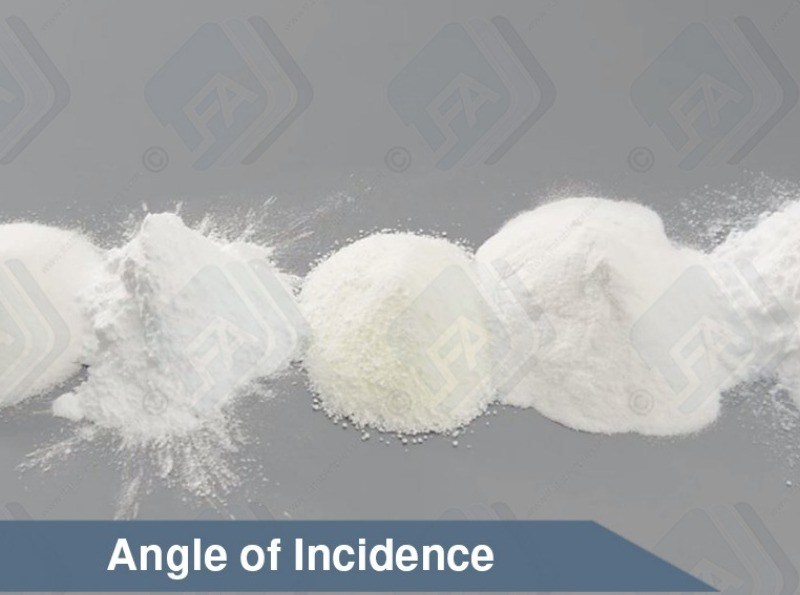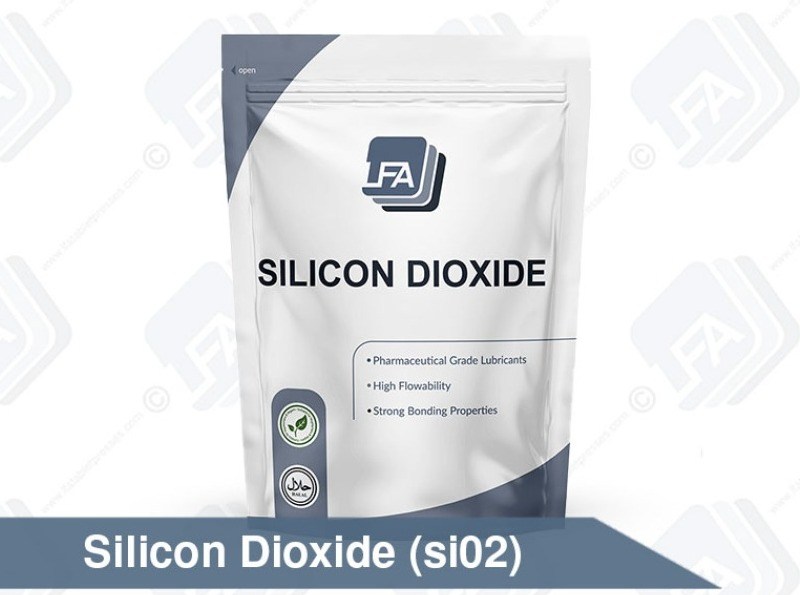Siliciumdioxide
Siliciumdioxide, ook bekend als silica, is een excipiënt. Het is multifunctioneel en zal het fabricageproces gemakkelijker maken. Siliciumdioxide is een inert bestanddeel. Dit betekent dat het niet reageert met andere ingrediënten of stoffen in het lichaam. Het maakt zowel de productie als de spijsvertering makkelijker. Het heeft een hoog smeltpunt en een hoger kookpunt en het is onoplosbaar in water. Er zijn natuurlijke en synthetische soorten kwaliteiten maar elk heeft een identieke chemische samenstelling. Het wordt vaak gebruikt omdat het de vloeibaarheid verhoogt en aankoeken op de gereedschappen tegengaat.
Siliciumdioxide absorbeert vocht uit zijn omgeving. Cosmetische en voedselfabrikanten gebruiken het vaak om deze reden. Deze toepassingen zijn ook gewenst door farmaceutische bedrijven. De verschillende voordelen werken samen om een eenvoudiger en soepeler productieproces te creëren.
Siliciumdioxide heeft een hoge porositeit waarmee het tot 300 g vloeistof per 100 g silica kan absorberen. Dit betekent dat vloeibare ingrediënten met gemak kunnen veranderen in vrij stromende poeders. Het fungeert als glijmiddel, om de stroomeigenschappen in de formule te verbeteren. Het zorgt ervoor dat het product door machines stroomt en niet aan de apparatuur kleeft. Met silicagel zal ook de stabiliteit van de vochtgevoelige API verhogen. Een API is een "actief farmaceutisch ingrediënt". Dit vermogen zal sporen van vocht, dat machines kan beschadigen verminderen. Het heeft een unieke vochtopname. Dit stimuleert snel tabletteren door zijn weerstand tegen blokkeren en plakken.
Siliciumdioxide is een interessant element dat in overvloed aanwezig is op deze aarde. Het bevindt zich overal op aarde en vormt 60% van de aardkorst en 93% van de rotsen. Het staat ook bekend als kwarts. Het komt voor in onze lichaamsweefsels, planten en in ons voedsel. Het is noodzakelijk voor gezonde botten, huid, haar, tanden en nagels. Siliciumdioxide deficiëntie kan leiden tot slechte botvorming, ongezonde huid en tanden.
Het is belangrijk om correct om te gaan met Siliciumdioxide. Dit zal de houdbaarheid van de producten verlengen en mensen veilig houden. Het kan de ogen en huid irriteren als zij eraan worden blootgesteld. Vermijd inademing en draag een masker bij de behandeling. Als het product goed wordt gebruikt, blijft het in uitstekende staat, totdat het is klaar voor gebruik.
Siliciumdioxide is een multifunctioneel, populair excipiënt. Het is effectief en maakt het productieproces efficiënter.
| Naam | Waarde |
|---|---|
| CAS Nummer | 7631-86-9 |
| Moleculaire formule | 60.08 g/mol |
| Uiterlijk | Wit poeder |
| Fysieke staat | Vast |
| Opslag | Bewaren op kamertemperatuur |
| Smeltpunt | 1,713 °C |
| Dichtheid | 2.648 (α-quartz) 2.196 (amorphous) g·cm−3 |
| Moleculair gewicht | 60.08 g/mol |
| Documenten |
Intolerantie Data Technische Specificaties |
Yes, we have bulk pricing for all of our excipients, and these can be found in this section. We offer bulk in 500 kg, 1 ton, 2 ton and 5 ton lots. The prices are set on these quantities as these are the amounts that will fit on pallets.
here are 6 steps that should be followed as a general rule of thumb when cleaning contact surfaces that have come into contact with powders:
Dry Clean - First you need to remove as much of the dry powder as possible. You can do this using a hover/vacuum. Make sure that the vacuum you are using has a filter good enough to handle fine dust.
Wet Clean - Next you need to perform a wet clean. This can be done with warm water and soap or if available an ultrasonic cleaner.
Rinse - Next you need to rinse off any soap with potable water (drinking water). You do not have to do this if you used an ultrasonic cleaner in the last step. It is important to ensure that all parts are thoroughly dried immediately after washing to avoid any rusting.
Sanitise - Next you need to sanitise the surface. This step is recommended by the FDA. There are a number of sanitising solutions available designed to be applied and left on.
Lubricate - You now need to lubricate any parts that require it. This should be with the appropriate grade oil or grease considering your use and greasing chart. Store - Finally store any of the parts in a cool dry place. If you are storing them on the machine then make sure the machine is in a temperature controlled environment with low humidity.
Firmapress - 2 years form batch date.
Dextrose - 3 years from batch date.
Dicalcium Phosphate - 3 years from batch date.
Microcrystalline Cellulose -
Magnesium stearate -
Lactose - 2 years from batch date.
Silica Dioxide - 2 years from batch date.
Firmapress - 2 years form batch date.
Dextrose - 3 years from batch date.
Dicalcium Phosphate - 3 years from batch date.
Microcrystalline Cellulose -
Magnesium stearate -
Lactose - 2 years from batch date.
Silica Dioxide - 2 years from batch date.
Dextrose - approx 100 mesh
Dicalcium Phosphate - approx 100 mesh
Microcrystoline Cellulose - approx 120-200
Magnesium sterate -
Lactose - 80 mesh
Silica Dioxide -
Firmapress - 100-200 mesh
Yes, all of the excipients are safe for human or animal consumption. There are some precautions that should be taken when handling them and there are some people that might have intolerances to some of them. Information on this can be found in the products MSDS and Intolerance Data Sheet. This can be found in this section for every excipient.
Yes, it does not matter what age, size or sex the person consuming the products is. It is, however, important to check the intolerance data.
Yes. CoA stands for Certificate of Analysis this is also known some times as an MSDS (Material Safety Data Sheet) all of the information contained in a CoA is inside the MSDS for every LFA product which is emailed to you after purchase.
Dextrose - Sweetener, binding agent, good for chewable tablets or candy.
Microcrystalline Cellulose - Binder, filling agent. Good at binding tablets and making them bigger. It can also be used as a filler for capsules.
Magnesium stearate - Dry Lubricant. This stops products from getting stuck to the tooling. It can also help with powder flow issues and caking issues.
Lactose - Binder, sweetener and bulking agent. It has a large mesh so it flows well but most people do not like it because of the intolerance issues.
Silica Dioxide - Flowing agent. This assist powders in flowing smoothly through the machines. It also helps with cacking issues where powders get stuck to the machine.
If your product or API is clumpy then you will need to add an anticaking agent. For this, we recommend silicon dioxide. We only recommend adding a maximum of 2% of this to the mix
If your product is sticky then you will need to add a dry lubricant to your mix. For this, we recommend magnesium stearate.
We do not recommend that you add more than 1% to the mix as more than this can cause capping. If your product is still sticky at this point then we would recommend looking into granulation.
If your product does not bind well then we would recommend using MCC. This can be used in any % the limiting factor is the size of the tablet.
If the amount of MCC you would have to use would be too much or if you do not want to use MCC then you have 3 other options: Ask your supplier for a directly compressible or tabletable grade of your product. Spray dry your product. Wet granulate your product.
Yes. There are two things at play here. You can get hygroscopic and hydrophobic excipients. Hygroscopic means that they take on water quickly, while hydrophobic means that they repel water.
There are products know as supper disintegrants. These products help the breakdown of tablets. At the moment LFA does not sell any supper disintegrants.
Magnesium stearate is hydrophobic this means that it will slow the breakdown of a tablet.
However, it is used in such small amounts that most of the time it will not make a difference to our customer's products. If they would like to be sure then they should conduct what is known as a disintegration test.
Yes, there are all of them can be found in the intolerance sheets for each product. The intolerance sheets can be found here: https://www.lfatabletpresses.com/product-data
FFFFFF 







